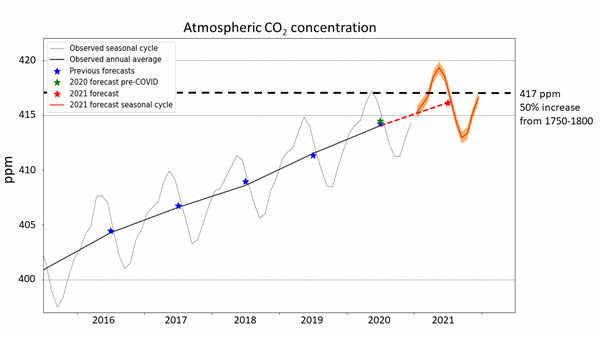Atmospheric CO2 will pass an alarming milestone in 2021
We are approaching a 50% increase from preindustrial times.

Atmospheric carbon dioxide (CO2) concentration will soar past a scary threshold this year, exceeding 417 parts per million (ppm) — a 50% increase since the start of widespread industrial activity in the 18th century.
The forecast comes from the Met Office, the national meteorological service for the U.K., which used data collected at Mauna Loa Observatory in Hawaii. Even though there was a slight decrease in global greenhouse gas emissions in 2020 because of the COVID-19 pandemic and the current La Niña event (a weather pattern in the Pacific that usually lowers global carbon emissions), it wasn't enough to offset previous increases.
"Since CO2 stays in the atmosphere for a very long time, each year's emissions add to those from previous years and cause the amount of CO2 in the atmosphere to keep increasing," Richard Betts, head of the climate impacts group at the Met Office and lead researcher for the forecast, said in a statement.
Related: 10 steamy signs in 2020 that climate change is speeding up
The concentration of CO2 in the atmosphere follows predictable seasonal variations. Levels peak in May and then decrease over the summer as plants grow across the Northern Hemisphere and suck in carbon (with photosynthesis), before rising again from September onward.
Although the total amount of CO2 emitted worldwide in 2020 was down 7% from previous years, emissions have almost returned to pre-pandemic levels, according to the Met Office.
The current La Niña event, which has been causing unusually cool weather since the middle of 2020, is also expected to reduce the rate of increase in CO2 this year. This is due to a temporary increase in the amount of carbon stored in ecosystems like tropical forests, which grow more quickly in cooler conditions.
Get the Space.com Newsletter
Breaking space news, the latest updates on rocket launches, skywatching events and more!
However, that's still not enough to stop the planet from reaching the ominous CO2 milestone this year.

Runaway acceleration
Mauna Loa Observatory keeps the longest-running continuous record of atmospheric CO2 concentrations in the world.
Since climate scientist Charles David Keeling started these records in 1958, scientists have used the data to track atmospheric CO2 levels using the Keeling Curve, a graph that has become an iconic symbol of humanity's growing impact on the global climate system.
That means we have a lot of work to do to meet the International Panel on Climate Change's goal of limiting global warming to 1.5 degrees Celsius (2.7 degrees Fahrenheit) above preindustrial levels.
"Reversing this trend and slowing the atmospheric CO2 rise will need global emissions to reduce, and bringing them to a halt will need global emissions to be brought down to net zero," Betts said. "This needs to happen within about the next 30 years if global warming is to be limited to 1.5 degrees Celsius."
The Met Office released the CO2 forecast for 2021 on Jan. 8.
Originally published on Live Science.
Join our Space Forums to keep talking space on the latest missions, night sky and more! And if you have a news tip, correction or comment, let us know at: community@space.com.

Harry is a U.K.-based staff writer at Live Science. He studied Marine Biology at the University of Exeter (Penryn campus) and after graduating started his own blog site "Marine Madness," which he continues to run with other ocean enthusiasts. He is also interested in evolution, climate change, robots, space exploration, environmental conservation and anything that's been fossilized. When not at work he can be found watching sci-fi films, playing old Pokemon games or running (probably slower than he'd like).

